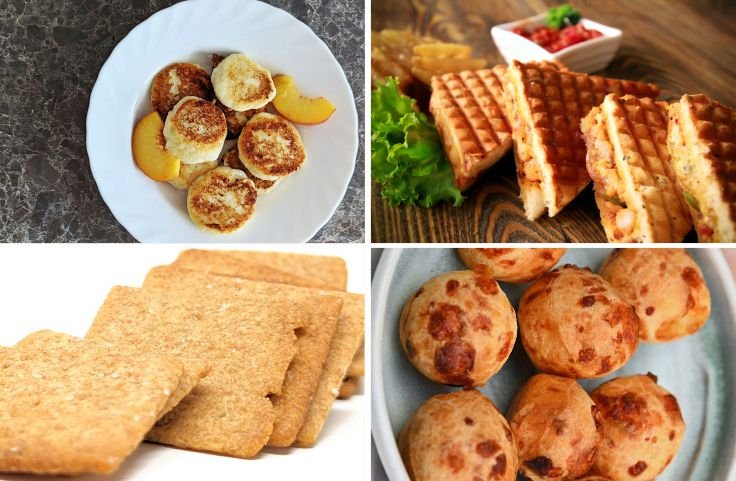Tapioca recipes bring gluten-free comfort to your table with sweet and savory dishes you can enjoy daily. Learn how to cook with pearls, flour, or starch.
Are you looking for gluten-free recipes that feel familiar yet exciting? Tapioca might be just what your kitchen needs.
Made from the cassava root, tapioca comes in forms like pearls, flour, and flakes, giving you plenty of ways to cook with it.
You’ve probably tasted it in bubble tea or pudding, but that’s only the beginning.
From chewy desserts to crisp snacks and soft breads, tapioca works across sweet and savory dishes.
If you’re avoiding gluten or just want to try something different, this is your chance.
In this post, you’ll find easy, satisfying tapioca recipes from around the world.
You’ll also see how simple it is to make everyday meals more interesting using this one ingredient.
Let’s get started.
Recommended: What is Tapioca Pudding?
Table of Contents
- Main Points
- An Overview of Tapioca
- Tapioca Pearls Recipes: Soft, Chewy Delights
- Tapioca Starch Recipes: Thickening and Binding
- Tapioca Flour Recipes: Grain-Free Baking and Frying
- Tapioca Snacks: Crispy and Flavorful Bites
- Tapioca in Breakfast Dishes: Starting Your Day Right
- Global Dishes Featuring Tapioca: A Culinary Journey
- Conclusion
- Frequently Asked Questions
Main Points
- Tapioca flour adds soft texture and crispy edges to grain-free recipes like crepes, flatbreads, and light fries without using wheat.
- Tapioca pearls create chewy textures in puddings and drinks, soaking up flavors perfectly in warm desserts and cold bubble teas.
- Tapioca starch thickens sauces, stews, and soups while also binding ingredients in gluten-free batters for smooth, elastic cooking results.
- Tapioca makes crispy snacks like chips and crackers that hold seasonings well and deliver crunchy, flavorful bites in every munch.
- Tapioca adds energy-rich texture to breakfasts like porridge, pancakes, or stir-fries, making your morning meals hearty, gluten-free, and satisfying.
Recommended: Tapioca Snacks You Need to Experience
An Overview of Tapioca
Tapioca is a starch extracted from the cassava root, widely used in gluten-free cooking.
Native to South America, cassava is processed by peeling, washing, grinding, and separating the starch to create tapioca.
This starch is then formed into pearls, flour, or flakes. Tapioca pearls are used in desserts and bubble tea, while tapioca flour thickens sauces or replaces wheat flour in baking.
Tapioca flakes can add texture to meals. Though made from cassava, tapioca is mostly starch and does not carry the full nutrition of the root.
It must be properly processed to remove natural toxins.
Tapioca is safe to eat and brings chewiness, crunch, or smoothness to many dishes, depending on how you use it.
Want in-depth information about tapioca? See a dedicated post on what tapioca is, its types and uses.
Related: How to Choose The Best Tapioca Pearls for Pudding
Tapioca Pearls Recipes: Soft, Chewy Delights
Tapioca pearls are known for their chewy texture and are made from the starch of cassava root.
You’ll find them in both sweet and savory dishes across different cultures. Here are recipes made with tapioca pearls:
Classic tapioca pudding is the kind of comfort food that brings warmth or a cool, soothing treat depending on how it’s served. The pearls are boiled until soft, then gently simmered in milk with sugar and a touch of vanilla.
The result is creamy with small chewy bursts in every bite. Served warm, it’s cozy and nostalgic. Chilled, it becomes a refreshing dessert.
Coconut milk tapioca swaps dairy for a tropical twist. The pearls absorb the smooth coconut flavor while remaining chewy. With maple syrup or other non-dairy sweeteners, it fits perfectly into a vegan diet. It’s a light yet satisfying option after a spicy meal or as a daytime sweet.
Chocolate tapioca pudding adds cocoa to the base for a rich, indulgent flavor. Topped with berries or chocolate shavings, it offers variety without complicating the process. It’s a fun way to enjoy chocolate and tapioca together in one easy dessert.
Thai mango tapioca pudding combines coconut tapioca with ripe mango cubes for a chilled, fruity treat. After cooling slightly, the dish is topped with mango and sometimes mint. It’s perfect for hot days or when a light, tropical dessert is needed.
Bubble tea brings chewy tapioca pearls into your drinks. Boil large pearls, soak in syrup, and serve them in flavored teas like taro, matcha, or black milk tea. Each sip has a fun texture, and the recipe is easy to customize at home.
Sabudana kheer, made with tapioca pearls popular in Indian cuisine, is simmered in milk with sugar, cardamom, and nuts. It’s creamy, lightly spiced, and often enjoyed during Hindu fasting, though its comforting taste makes it welcome any time.
Related: What Does Tapioca Pudding Contain?
Tapioca Starch Recipes: Thickening and Binding
Tapioca flour helps you add structure, chew, and thickness to different dishes.
It’s gluten-free, easy to work with, and fits into both sweet and savory recipes from many cultures.
Here are some of the recipes from tapioca starch:
Pão de queijo is a chewy, gluten-free Brazilian cheese bread made with tapioca starch, eggs, and cheese. The starch gives it stretch and airiness without using wheat. These rolls bake into light puffs and are best enjoyed warm. They’re quick to prepare, freezer-friendly, and ideal for breakfast or snacks.
Tapioca crepes are made from just starch and water, cooked in a dry pan until soft and flexible. They don’t tear easily and work with both sweet and savory fillings. You can use them like wraps or roll them up for a light meal. They’re fast to make and deliver a crisp edge when freshly cooked.
Tapioca tortillas offer a chewy and bendable gluten-free option for tacos and wraps. The dough uses starch, warm water, and oil, then gets pressed and pan-cooked. These tortillas hold fillings well and are perfect with vegetables, meat, or cheese.
Tapioca cheese balls combine starch and cheese to form crunchy bites with gooey centers. The starch binds the dough and crisps the outside during baking. You can customize them with herbs or spices for extra flavor, and they make easy, no-fuss snacks.
Related: Tapioca Crepes: The Brazilian Gluten-Free Delight
Tapioca Flour Recipes: Grain-Free Baking and Frying
Tapioca flour, made from cassava root, is perfect for grain-free baking and frying. It brings a smooth, stretchy texture to recipes and adds mild sweetness without gluten or grains. It’s great for breakfast, snacks, and even frying.
Tapioca pancakes are soft and fluffy. They’re made with tapioca flour, eggs, and milk, then cooked into golden rounds. These pancakes pair well with fruit or nut butter. You can mix in cinnamon or banana for extra flavor. They’re light, satisfying, and easy on digestion, making them a great way to start your morning.
Tapioca waffles have a crisp outside and soft inside. Just tweak your pancake batter by adding baking powder and use a waffle iron. The flour helps hold the shape while keeping the texture light. Serve with toppings like berries or chocolate. These waffles are freezer-friendly and perfect for busy mornings or relaxed brunches.
Tapioca sticks are a crunchy, fun snack. Combine tapioca flour with warm water, oil, and spices. Shape into sticks and fry until crisp and airy. Serve with dips or season to your liking. They’re great for sharing or as a side.
Tapioca flour also works well for gluten-free breading. It gives a crisp finish when frying veggies, chicken, or fish. The coating stays light and crunchy. You can use it alone or mix it with spices or cornmeal. It’s a reliable, wheat-free option for delicious, crispy fried food.
Related: Easy Tapioca Tortillas Recipe
Tapioca Snacks: Crispy and Flavorful Bites
Tapioca snacks give you tasty, gluten-free options that are easy to make at home. You can enjoy them baked or fried, sweet or savory, with simple ingredients and bold flavors.
Tapioca chips are made by slicing firm tapioca dough into thin rounds and frying or baking them until crisp. You can season them with salt, garlic powder, paprika, or chili for extra flavor. These chips are light and crunchy, perfect with dips like hummus, salsa, or guacamole. If you prefer a healthier version, baking still gives you a satisfying crunch.
Tapioca crackers start with a dough made from tapioca flour, water, and spices. Roll it out, cut it into shapes, and bake until golden. You can mix in herbs like thyme or rosemary and press seeds into the dough for texture. These crackers go well with spreads or soups and store well for snacking.
For something warm, try savory tapioca puffs. Fill the dough with cheese, mashed vegetables, or seasoned meat. Fry or bake until golden on the outside and soft inside. They’re perfect for gatherings or a cozy snack at home.
Related: Best Toppings For Tapioca Waffles
Tapioca in Breakfast Dishes: Starting Your Day Right
Tapioca makes a great gluten-free start to the day, especially in warm porridge.
Cook the pearls in milk or dairy-free options and flavor with vanilla, cinnamon, or fruit.
The result is creamy, mildly sweet, and full of energy-giving carbs.
It’s a simple, cozy dish that suits both slow weekend mornings and busy weekdays.
Tapioca breakfast bowls are colorful and satisfying. Start with a base of soft pearls, then top with fruit, seeds, and maybe some yogurt.
You can mix in chia seeds or granola for added nutrition and crunch. This meal is easy to customize, letting you adapt it to your cravings and health needs.
Smoothies with tapioca pearls add fun texture and fullness. A blend of pineapple, banana, and spinach becomes more filling with a spoonful of cooked pearls.
Prep a big batch in advance and keep it in the fridge for quick, nourishing mornings that don’t compromise flavor or variety.
Related: Easy Chocolate Tapioca Pudding Recipe
Global Dishes Featuring Tapioca: A Culinary Journey
Tapioca shows up in kitchens all over the world, transforming into dishes that are rich in culture, taste, and texture.
Here’s how you’ll find it cooked around the globe:
Brazil: Tapioca Crepes Packed with Flavor
In Brazil, tapioca crepes are a breakfast or street food favorite.
You start with hydrated tapioca flour, press it into a pan until it binds, then cook until it crisps slightly.
The best part: you can fill it with anything you like. Try cheese and oregano for something savory, or go sweet with grated coconut and condensed milk.
This gluten-free dish is fast, filling, and deeply rooted in Brazilian culinary traditions. See a dedicated post on how to make tapioca crepes here.
India: Sabudana for Fasting and Feasting
In India, especially during fasting seasons, tapioca pearls, called sabudana, take center stage.
You might prepare sabudana khichdi with soaked pearls tossed in cumin, green chili, roasted peanuts, and potatoes.
If you want dessert, make sabudana kheer: simmer the pearls in milk with sugar and cardamom.
Both dishes highlight tapioca’s ability to absorb flavor and provide energy without gluten or grains.
Southeast Asia: Sweet Coconut Bliss in Every Bite
In Vietnam and Thailand, tapioca pairs naturally with coconut.
In Vietnam, chè bánh lọt is a chilled dessert of pandan-colored tapioca noodles in sweet coconut milk, often topped with jackfruit or beans.
Thailand’s version shows up in drinks too, bubble tea with chewy tapioca pearls or desserts like tapioca in coconut cream.
These recipes mix texture and tropical flavor to satisfy your sweet cravings.
Around the World: From Street Food to Dessert Tables
Tapioca adapts to local flavors wherever it lands. In Africa, cassava-based tapioca is cooked into porridge.
In Caribbean islands, it turns up in puddings and cakes.
You can use it to thicken soups, bake gluten-free breads, or even make crispy fritters.
Tapioca works across cuisines because it’s simple, absorbent, and just waiting for your flavor choices.
Conclusion
Tapioca brings comfort and flexibility to your kitchen, no matter what you’re in the mood for.
Whether you’re boiling pearls for pudding, stirring starch into bread, or frying snacks with flour, each method offers a fresh way to cook gluten-free meals that don’t feel restrictive.
You can keep it simple or try flavors from around the world, Brazilian crepes, Indian khichdi, Thai mango tapioca, and more.
The best part is you don’t need special skills to get started. Tapioca is easy to work with and fits right into your usual routine.
Swap it into your baking, blend it into smoothies, or make quick snacks for the week. It’s practical, tasty, and ready to be part of breakfast, dessert, or anything in between.
Use these recipes as a guide, but don’t be afraid to make them your own.
With just a few ingredients, tapioca turns everyday meals into something new and worth repeating.
Frequently Asked Questions
Can I substitute cornstarch with tapioca starch?
Yes, tapioca starch can replace cornstarch in most recipes. It offers a smoother, glossier finish and works well in puddings, sauces, and pie fillings.
Are tapioca recipes safe for gluten-intolerant people?
Most tapioca recipes are naturally gluten-free, making them suitable for those with gluten intolerance. Always check other ingredients for hidden gluten additives.
What’s the difference between cassava and tapioca recipes?
Cassava recipes use the whole root, while tapioca recipes focus on the starch extracted from cassava. Texture, flavor, and preparation methods vary significantly.
Is tapioca low-carb or keto-friendly?
Tapioca is high in carbs and not keto-friendly. It’s best avoided on low-carb diets, though small amounts may fit flexible carb limits occasionally.
References

Chimeremeze Emeh is a writer and researcher passionate about Africa’s most transformative root crop—cassava. Through his work at cassavavaluechain.com, he explores the entire cassava industry, from cultivation and processing to its diverse applications in food, health, and industrial use.
He also writes for palmoilpalm.com, where he shares his extensive experience and deep-rooted knowledge of palm oil, covering red palm oil, palm kernel oil, and refined products. His work there reflects his lifelong connection to agriculture and his commitment to promoting sustainable value chains in Africa.
Driven by curiosity and purpose, Chimeremeze aims to shed light on how cassava continues to empower communities, strengthen food systems, and link traditional farming wisdom with modern innovation.

